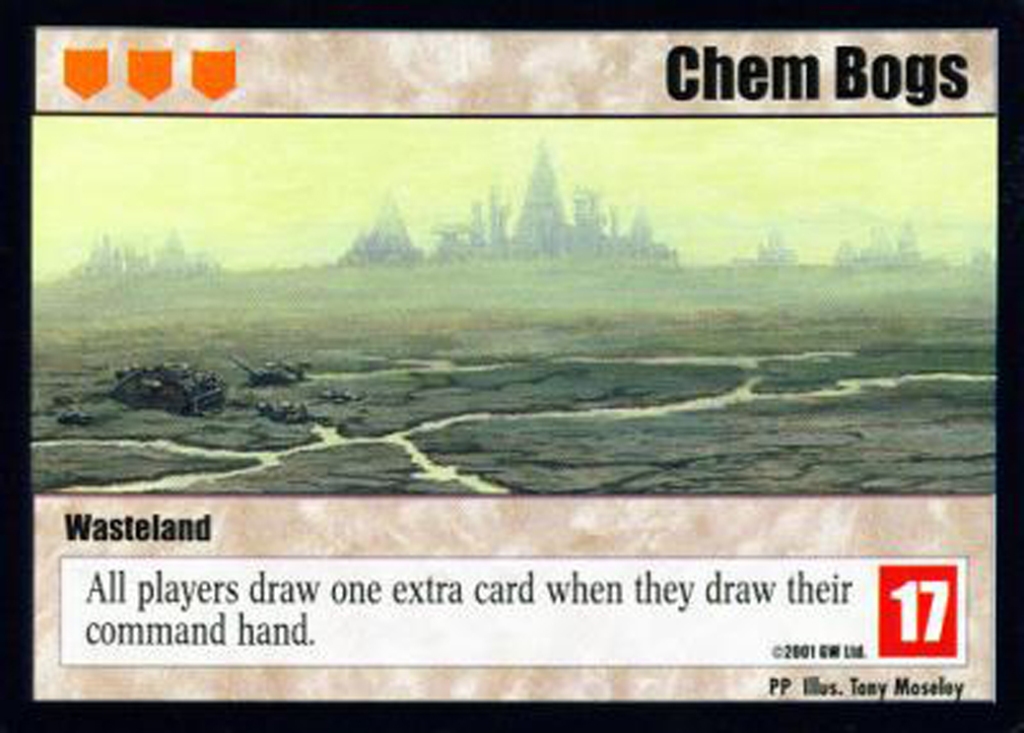I believe that deployment is the most complex and difficult part of playing the 40K CCG. Your decisions will change dynamically based on the army you’re playing, as well as the opponent you’re playing. While there are some general “best practices” to follow, the best way to understand the deployment subgame is to simply play the game.
Some factors, however, are always constant. Among these:
- Each planet has 5 sectors, and to win you must capture 3 or hold more victory points than your opponent after the end of 4 turns.
- The victory points of each sector do not change between sets. There will always be an 11, 12, 14, 17, and 21 point sector on each planet.
- Each sector will have gameplay text that will influence your decision about how to allocate your forces to take (or avoid) that sector.
- The 11-point sector will always be the easiest to capture, as it only requires 2 flags.
- The 21-point sector will always be the most difficult, as it requires 4 flags. However, capturing the 21-point sector plus any other sector will always give you a victory point advantage.
Now, let’s take a look at the sectors of Pandora Prime:

The Barbican Peaks has an ability to override the first BA rule normally dictated by the attacker/defender designation. This ability favours the defender, as it is the defending player who gets to choose the first sector every turn. If the defender chooses to pass on this opportunity, the attacker then gains the advantage when choosing the second battle of the turn.

Most races do not like the Black Maze – but more so Chaos, Eldar, Dark Eldar, and Imperial Guard. With “denial-type” sectors such as the Black Maze, you have two options: 1) capture it quickly, because your opponent will avoid it and because you also do not want to fight there, or 2) delay fighting there until the end of the game, because choosing it as the final sector will put your opponent at a severe disadvantage. Because each turn plays unpredictably, it will be a judgment call to determine whether you have the time or the units to employ this strategy.

The Ardeas Valley is similar to the Black Maze in that no one likes it. However, Chaos and Space Marines hate this sector the most, so use this to your advantage if you are playing against them.

The Chem Bogs is the opposite of the Black Maze and Ardeas Valley in that it benefits everyone. Space Marines, however, will especially like the Bogs in order to have an extra large command hand, and Eldar get to see an extra card before deciding if they want to re-draw a new command hand. Similarly, Dark Eldar get to see an extra card before choosing a unit to infiltrate.

Oberon Hive City is a lynchpin sector by virtue of being the 21-point sector, but it is otherwise quite unexciting. Most races will not get a huge benefit to the character flag bonus aside from Space Marines, who generally play a high number of characters. As a general note, capturing the 21-point sector in a game can give you a great advantage in dictating the pace of subsequent turns, as you are usually much closer to winning than your opponent.
Sector Summary
As far as planets go, Pandora Prime feels generally OK to play on. I’m not a fan of denial-type sectors (unless they especially hamper Chaos, but that is just my bias), and prefer sectors that give bonuses based on how you play. I generally like playing on sectors similar to the Chem Bogs, and I like the mechanics of the Barbican Peaks although it may seem too straightforward (e.g., the defender usually picks the Peaks first because of the bonus).
However, I will stress that during a 40K CCG game, many factors will change constantly, so it’s important to think on your feet to find the best way to win.
In the next article in the mini-series, we’ll cover the Coronis sectors, and why the 11-point sector is probably the worst-designed sector of them all.






5 replies on “Sectors 101: Pandora Prime”
Does the decision to take your opponent’s most unfavourable sector early and uncontested or save it for the final battle depend on the strength of one’s deployment hand? In other words, if one has a strong deployment hand, then one would prefer to fight as much as possible instead of trading, right?
LikeLiked by 1 person
I think it is a higher priority to focus on establishing a VP advantage in the first turn. At such an early point in the game I don’t think it’s easy to predict where the last battle will be, and on certain planets there may not be a clear-cut “worst” sector for the opponent.
LikeLiked by 1 person
Except always go all-in on Magnor Atoll.
LikeLiked by 1 person
Who decides what sector players are fighting for? It’s chosen randomly? How it worked in the past, in tournament scene?
LikeLiked by 1 person
I believe players used the sectors from the most recent expansion, so if you played when Delos V was just released, you’d use those sectors. These days we just choose a random planet for the session. If I were to run a tournament today, I’d announce the planet ahead of time for all players to use.
LikeLiked by 1 person